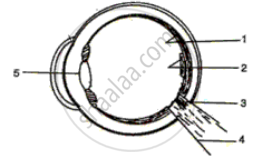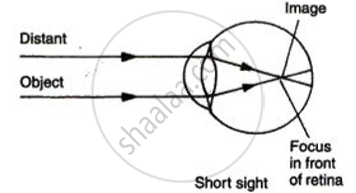Advertisements
Advertisements
प्रश्न
The diagram alongside represents a section of a mammalian eye.
(i) Label the parts 1 to 5 of the diagram.
(ii) State the function of the parts labelled 4 and 5.
(iii) With the help of a diagram show the short sightedness.

उत्तर
(i) 1- Retina
2 - Yellow spot
3 - Blind spot
4 - Optic nerve
5 - Lens
(ii) Optic nerves - It transmits the impulses to the brain.
Lens - It focuses the image on the retina.
(iii) Short sightedness:

APPEARS IN
संबंधित प्रश्न
What is myopia?
Millions of people in the developing countries of the world are suffering from corneal blindness. These persons can be cured by replacing the defective cornea with the cornea of a donated eye. A charitable society of your city has organised a campaign in your neighbourhood in order to create awareness about this fact. If you are asked to participate in this mission, how would you contribute in this noble cause?
(i) State the objective of organising such campaigns.
(ii) List two arguments which you would give to motivate the people to donate their eyes after death.
(iii) List two values which are developed in the persons who actively participate and contribute in such programmes.
What is the far point and near point of the human eye with normal vision?
Which defect of vision can be rectified:
by using a concave lens?
Differentiate between myopia and hypermetropia. What type of spectacles should be worn by a person having the defects of myopia as well as hypermetropia? How does it help?
A person having short-sight cannot see objects clearly beyond a distance of 1.5 m. What would be the nature and power of the corrective lens to restore proper vision?
A person cannot see the distant objects clearly (though he can see the nearby objects clearly). He is suffering from the defect of vision called:
(a) cataract
(b) hypermetropia
(c) myopia
(d) presbyopia
Differentiate between members of the following pair with reference to what is asked in the bracket.
Rods and cones (sensitivity).
What is meant by optical illusion? Give one example.
Have a look at the posture of this girl who is reading a book and answer the questions which follow:

Name the problem she is facing.
What eye defect is hypermetropia? Describe with a ray diagram how this defect of vision can be corrected by using an appropriate lens.
A student has difficulty reading the blackboard while sitting in the last row. What could be the defect the child is suffering from? How can it be corrected?
Distinguish between the following pair of words:
Myopia and hypermetropia
Name the common defects of the eye.
Give Reason:
Why do we see clearly in the central region of the retina?
Give Technical Term:
The type of lens used to correct myopia is
Myopia and hypermetropia can be corrected by:
Observe the figure and answer the following questions:

- Name the defect of vision represented in the above figure.
- State the reasons for this defect.
- How is it corrected?
- Draw the diagram to show the correction of this defect.
A person is unable to see clearly a poster fixed on a distant wall. He however sees it clearly when standing at a distance of about 2 m from the wall.
- Draw ray diagram to show the formation of image by his eye lens when he is far away from the wall.
- List two possible reasons of this defect of vision.
- Draw ray diagram to show the correction of this defect using appropriate lens.
Name the following:
Two kinds of accomodations.
